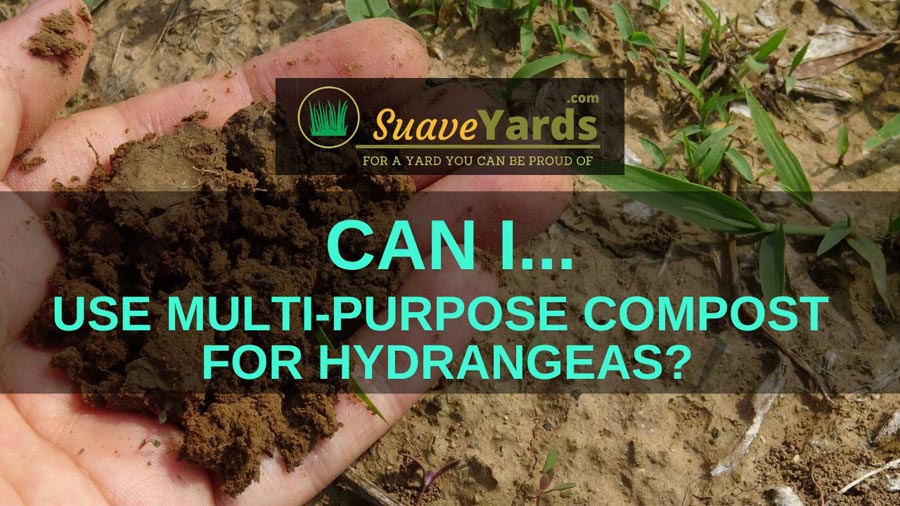
So you want to know ‘can I use multi-purpose compost for hydrangeas?’
It is a perfectly valid question because, by its name alone, you might assume it is fine to use it with your hydrangeas.
We will take a closer look at the subject and try to decide what is the best compost for hydrangeas.
So without further ado, let’s get started.
Can I Use Multi-Purpose Compost For Hydrangeas?
Yes, you can and you most definitely should in most instances. Hydrangeas are nearly always best suited to a mix of multi-purpose compost and loam-based compost. This provides all the nutrients they need to thrive and the moisture they like in the soil. The only exception to this is if you are trying to get blue blooms from your hydrangea, then you want to use ericaceous compost, which is more acidic.
It is Fine to Use Multi-Purpose Compost on Your Hydrangeas
Hydrangeas love a nice balanced diet.
Nitrogen, potassium and phosphorous in equal amounts are the basic ingredients they need to thrive.
Thankfully, this is more or less the exact balance you get in most multi-purpose compost products.
As the name suggests multi-purpose compost is designed to benefit a wide range of plants and in a wide range of applications throughout all stages of their growth.
It is usually made up of a mix of peat, bark, fertilizer, lime and some other ingredients.
It is nutrient-rich and helps maintain a pH level suitable for a whole host of plants.
So can you use multi-purpose compost on your hydrangeas?
Yes, you most definitely can!
But It Is Best Used Mixed
For optimum results when it comes to growing your hydrangeas use multi-purpose compost mixed with a loam-based compost such as John Innes No 3.
The benefit of a loam-based compost is best explained by gardening expert, John Negus:
“The best potting compost for shrubby plants is one with a high proportion of loam, such as John Innes No.3. Loam-based composts hold on to moisture better than peat-based ones” he explains.
RELATED ===> Can Rose Fertilizer Be Used On Hydrangeas?
You want your mixture to be somewhere between 50/50 and two-thirds John Innes No 3 and one-third a good multi-purpose compost.
Hydrangeas like constant moisture and a mixture like this will hold moisture much better than multi-purpose compost on its own.
Good multi-purpose compost will have enough nutrients in it to sustain your hydrangea for around two months.
After this simply give it a gentle feed with liquid fertilizer or top-dress them early in the summer and they will be happy plants.
What Is So Great About Loam-Based Compost?
We’ve hinted at it above, but loam-based composts are great for hydrangeas and many other plants.
Loam-based soil is a soil that is a balanced mixture of mineral components of different sizes, clay, sand and silt for example. The ratio of which is roughly 40%, 40%, and 20% respectively.
These soils are great for gardeners as the components encourage plant growth by combining the best aspects of a variety of soils.
RELATED ===> Can Tomorite Be Used On Hydrangeas?
Thus loam-based composts have similar benefits.
As mentioned the main advantage for plants like hydrangeas is the fact the soil retains moisture much better, and hydrangeas love moisture.
But it also drains away at such a rate it doesn’t leave the roots of your hydrangea sitting in it and potentially rotting.
The downside to this though is the need for constant moisture does mean hydrangeas are not really ideal pot plants.
However, almost anything can grow in loam soil, from fruit trees to vegetables and from annuals to perennials.
There Is One Occasion When You Might Want To Use a Different Type of Compost
A mixture of multi-purpose compost and loam-based compost is what you want in every scenario when it comes to growing hydrangeas.
Apart from one.
If you want blue hydrangeas.
Multi-purpose compost and a loam-based compost will keep your hydrangea pink or white.
But if you want blue blooms your best bet is to use ericaceous compost.
Ericaceous compost is compost with a pH of between 4 and 5. Normal compost usually has a pH of between 6 and 8.
RELATED ===> Are Banana Peels Good For Hydrangeas?
This means ericaceous compost is acidic.
As a reminder of how the pH of soil affects hydrangeas:
- Soil pH of 5.5 or lower: blue flowers
- Soil pH of 5.5 to 6.5: purple flowers
- Soil pH of 6.5 or higher: pink flowers
So as you can see, if you can lower the pH of your soil then it will change the color of the flowers of your hydrangea. Although note that white or cream hydrangeas DON’T change color.
Using ericaceous compost might not be enough though.
Hydrangeas turn blue as they take up the aluminum ions from soil. These ions are more easily available to the plant when the soil is acidic.
Adding aluminum sulfate or hydrangea colorant to the soil, in conjunction with ericaceous compost, should see your hydrangeas sporting blue flowers.
Final Thoughts
So if you have been wondering if you can use multi-purpose compost for your hydrangeas, hopefully this has answered your question.
Multi-purpose compost provides a nice balanced mix of nitrogen, potassium and phosphorous that is ideal for hydrangeas. They love any soil that is nutrient rich.
But for the best results, you want to mix it with a loam-based compost such as John Innes No. 3.
This will help retain moisture in the soil better, something that is very important to a happy and healthy hydrangea.
The only time you would want to venture away from using a mix of multi-purpose compost and loam-based compost, is if you are trying to get blue blooms from your hydrangea.
Then ericaceous compost is a better bet.
